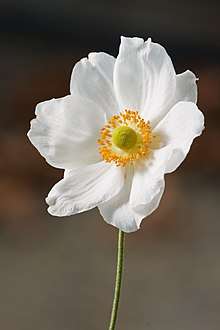Anemone hupehensis
Anemone hupehensis, Anemone hupehensis var. japonica, and Anemone × hybrida (commonly known as the Chinese anemone or Japanese anemone, thimbleweed, or windflower) are species of flowering herbaceous perennials in the family Ranunculaceae.
| Anemone hupehensis | |
|---|---|
 | |
| Japanese anemones have yellow stamens and five white or pink petals. | |
| Scientific classification | |
| Kingdom: | Plantae |
| Clade: | Tracheophytes |
| Clade: | Angiosperms |
| Clade: | Eudicots |
| Order: | Ranunculales |
| Family: | Ranunculaceae |
| Genus: | Anemone |
| Species: | A. hupehensis |
| Binomial name | |
| Anemone hupehensis | |
| Type | Flower |
|---|---|
| Light | Partial shade |
| Water | Moderate to large amount |
| Soil | Acidic soil |
| Hardiness | USDA Zone 4a to 8 |
| Bloom Period | White, pink, or purple color, late summer to early fall |
| Propagation | Root cutting[1] |
Anemone × hybrida Paxton is a hybrid of Anemone hupehensis var. japonica and Anemone vitifolia.[2] It should not be confused with Anemone hybrida Miq. ex Pritz., a synonym of Anemone halleri All.
Description
Height is 3–4 ft (1–1 m). Leaves have three leaflets. Flowers are 40–60 mm (1.6–2.4 in) across, with 5-6 (or up to 20 in double forms) sculpted pink or white sepals and prominent yellow stamens, blooming from midsummer to autumn.
Taxonomy
Within the genus Anemone, A. hupehensis is situated within subgenus Anemone, section Rivularidium.[3] A. huppehensis var. japonica (Thunb.) Bowles & Stearn is more correctly named A. scabiosa H.Lév. & Vaniot.[4]
History
A. hupehensis is native to central China, though it has been naturalised in Japan for hundreds of years.
The species was first named and described in Flora Japonica (1784), by Carl Thunberg. Thunberg had collected dried specimens while working as a doctor for the Dutch East Indies Company.[5] In 1844, Robert Fortune brought the plant to England from China, where he found it often planted about graves.[6]
Cultivation
These plants thrive best in shady areas and under protection of larger plants, and in all but the hottest and the driest conditions in the United States.[7] They are especially sensitive to drought or overwatering.[5] They can be invasive or weedy in some areas,[8] throwing out suckers from the fibrous rootstock, to rapidly colonise an area. Once established they can be extremely difficult to eradicate.[9] On the other hand, they can take some time to become established.[10] A. hupehensis is one of a handful of species that are autumn flowering.[11]
Cultivars
The following cultivars have gained the Royal Horticultural Society's Award of Garden Merit:
Gallery
 Seeds
Seeds Flower and unripe seedheads in a private garden
Flower and unripe seedheads in a private garden Anemone hupehensis by A.J. Wendel, 1868
Anemone hupehensis by A.J. Wendel, 1868
References
- "Anemone hupehensis/Anemone japonica". Rob's Plants. Retrieved 7 January 2010.
- "Learn2Grow: Anemone × hybrida 'Pamina'". Archived from the original on 2012-02-24. Retrieved 2010-05-29.
- Wang et al 2009.
- The Plant List 2013, Anemone hupehensis var. japonica
- Klingaman, Gerald (13 October 2006). "Plant of the Week Japanese anemone Latin: Anemone x hybrida". University of Arkansas Division of Agriculture. Archived from the original on 29 September 2011. Retrieved 2010-01-07.
- "Anemone hupehensis 'Kriemhilde'". Paghat the Ratgirl. Retrieved 2010-01-06.
- "Anemones". plantideas.com. Archived from the original on 23 December 2009. Retrieved 2010-01-07.
- "Anemone hupehensis var. japonica 'Bressingham Glow' (Japanese anemone)". The Taunton Press. Archived from the original on 3 January 2010. Retrieved 2010-01-07.
- RHS A-Z encyclopedia of garden plants. United Kingdom: Dorling Kindersley. 2008. p. 1136. ISBN 978-1-4053-3296-5.
- Feather, Judy (5 January 2010). "Japanese Anemone: Fall Color in the Garden". CSU/Denver County Extension Master Gardener. Archived from the original on 11 March 2010. Retrieved 2010-01-08.
- Rudy 2004.
- "RHS Plant Selector – Anemone hupehensis 'Bowles's Pink'". Retrieved 23 February 2020.
- "Anemone × hybrida 'Elegans'". RHS. Retrieved 12 April 2020.
- "RHS Plant Selector – Anemone hupehensis 'Hadspen Abundance'". Retrieved 23 February 2020.
- "RHS Plant Selector – Anemone x hybrida 'Honorine Jobert'". Retrieved 23 February 2020.
- "RHS Plant Selector – Anemone x hybrida 'Konigin Charlotte'". Retrieved 23 February 2020.
- "RHS Plant Selector – Anemone hupehensis var. japonica 'Pamina'". Retrieved 23 February 2020.
- "RHS Plant Selector – Anemone x hybrida 'September Charm'". Retrieved 23 February 2020.
Bibliography
- Rudy, Mark R (2004). "Fall-blooming Anemone". Plant Evaluation Notes. Chicago Botanic Garden (25).CS1 maint: ref=harv (link)
- Wang, Wei; Lu, An-Ming; Ren, Yi; Endress, Mary E.; Chen, Zhi-Duan (January 2009). "Phylogeny and classification of Ranunculales: Evidence from four molecular loci and morphological data". Perspectives in Plant Ecology, Evolution and Systematics. 11 (2): 81–110. doi:10.1016/j.ppees.2009.01.001.
- "Anemone hupehensis". World Checklist of Selected Plant Families (WCSP). Royal Botanic Gardens, Kew. Retrieved 7 July 2015 – via The Plant List.CS1 maint: ref=harv (link)
- "Anemone hupehensis var. japonica". World Checklist of Selected Plant Families (WCSP). Royal Botanic Gardens, Kew. Retrieved 7 July 2015 – via The Plant List.
- Wang, Wencai; Ziman, Svetlana N.; Dutton, Bryan E. "Anemone hupehensis". Flora of China. 6 – via eFloras.org, Missouri Botanical Garden, St. Louis, MO & Harvard University Herbaria, Cambridge, MA.
External links
| Wikimedia Commons has media related to Anemone hupehensis. |
| Wikispecies has information related to Anemone hupehensis |